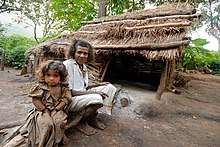Soliga people
Soliga, also spelled Solega, Sholaga and Shōlaga, is an ethnic group of India. Its members inhabit the Biligiriranga Hills and associated ranges in southern Karnataka, mostly in the Chamarajanagar and Erode districts of Tamil Nadu. Many are also concentrated in and around the BR Hills in Yelandur and Kollegal Taluks of Chamarajanagar District, Karnataka. The Soliga speak Sholaga, which belongs to the Dravidian family. Under Indian law, they are recognized as a scheduled tribe, they have a population of around 40,000.
 A Soliga man with a child. | |
| Total population | |
|---|---|
| 40,000 | |
| Regions with significant populations | |
| Karnataka | 33,819 |
| Tamil Nadu | 5965 |
| Languages | |
| Sholaga | |
| Related ethnic groups | |
| Irula, Tamil, Yerukala | |
Origin
The Soliga tribe trace their origin to Karayya, son of Lord Maleya Mahadeshwara, swamy of Maleya Mahadeshwara Hills, Karnataka.[1] Legend says that on seeing Karayya's affinity towards wild animals, Lord Maleya Mahadeshwara swamy asked Karayya to reside in forests, whereas the other son Biliyayya resided in plains and became the forefather of Lingayats.[1]
A genetic study suggested that the Soligas have 30% similarity with Aboriginal Australians from the Top End of Australia.[2]
Language
The Soliga speak the Sholaga language (Soliganudi) as a mother tongue. A member of the Dravidian family, it is most closely related to Kannada with several Tamil influences.[3]
Groups
There are five sub groups of Soligas:[1]
- Male Soliga: Kannada speakers residing in Karnataka
- Urali Soliga: Kannada and Tamil speakers, residing in border areas of Tamil Nadu
- Pujari group: reside in Maleya Mahadeshwara Hills
- Kadu Soliga: reside near Bandipur Forest
- Burude Soliga: reside in Heggadadevanakote Taluk and Kodagu
Furthermore, these groups have several sub-groups.[1]
Occupation and social status
The Soliga used to practice shifting cultivation, but have more or less given up this practice now. They grow Ragi (Finger millet, Eleusine coracana) for subsistence. Their main source of income is harvesting and sale of Non-timber Forest Produce (NTFP) like honey, nellikai (gooseberry, Emblica officinalis), bamboo, Paasi (Lichen), algae, wild turmeric, Indian blackberry, soapnut and nennari (wild root). They also make baskets using bamboo.[1]
They are increasingly being brought to the "mainstream" with active Government and NGO initiative. Many have been given lands closer to 'civilised areas' and most of the forest-dwelling population have been brought together into clusters called Podus. Most of the forest area they stay comes under wild life protection area. The Biligiriranga Hills is a Wildlife Sanctuary under Wildlife Protection Act, 1972, the Male Mahadeswara Hills is a Reserve Forest, and Bandipur is a National Park. Their rights on harvesting NTFP is being sought to be withdrawn citing conservation concerns, sparking a debate about the rights of indigenous people. The Soligas later won a court case to stay on their land.[4]
Religion
Soliga people follow naturism and animism along with following Hindu practices and their main deities are Madeshwara, Rangaswamy of Biligirirangana Hills (who is considered the brother-in-law of the clan), Karayya, Kyate Devaru and Jadeswamy.[1] Other deities worshipped by them include Madeshwara, Basaveshwara and Nanjundeshwara and Sri Alamelu Ranganayaki smetha Sri ranganatha.[1]
See also
References
- Singh, Nagendra Kr. Global Encyclopaedia of the South Indian Dalit's Ethnography, Volume 1 (2006 ed.). New Delhi: Global Vision Publication House. pp. 759–763. ISBN 9788182201682. Retrieved 6 September 2012.
- Morlote, Diana M.; Gayden, Tenzin; Arvind, Prathima; Babu, Arvind; Herrera, Rene J. (April 2011). "The Soliga, an isolated tribe from Southern India: genetic diversity and phylogenetic affinities". Journal of Human Genetics. 56 (4): 258–269. doi:10.1038/jhg.2010.173. ISSN 1435-232X.
- Buchanan, Francis (1870). A Journey from Madras Through the Countries of Mysore, Canara, and Malabar. Higginbotham and Co. ISBN 1108116302.
- Rajappa, Amoolya. "How a tribe in Karnataka fought and won a legal battle to stay in a tiger reserve". Scroll.in. Retrieved 26 June 2020.
External links
- Indian tribe secures unprecedented rights to tiger reserve Survival International
- The Soligas of Karnataka and their intimate relationship with nature on Biodiversity of India wiki